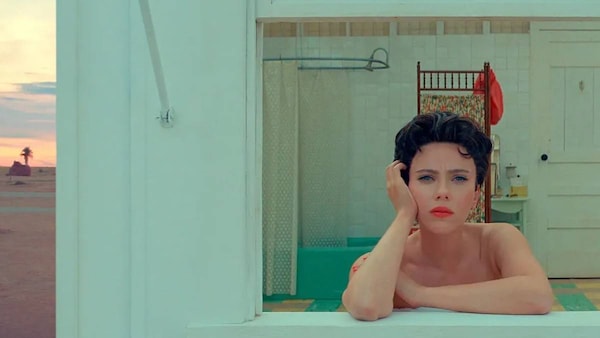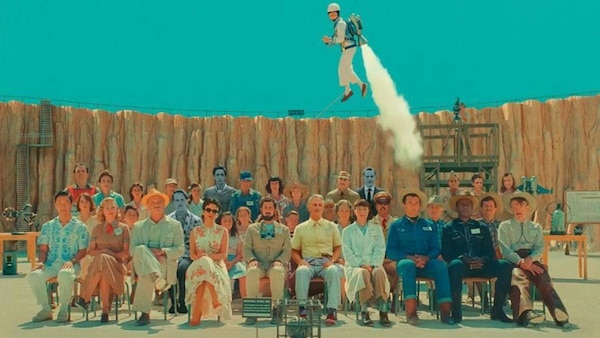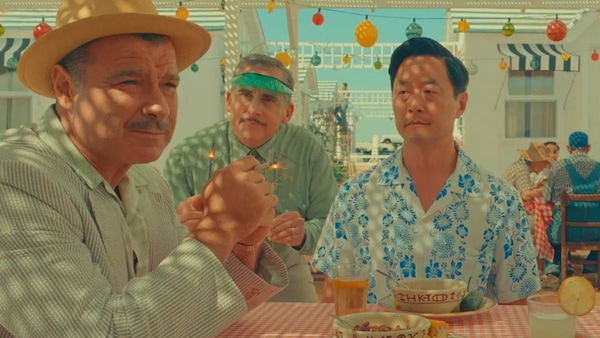Asteroid City Is 'Peak Wes Anderson' In The Best Sense Of The Term
Asteroid City works as a master key that decodes all Anderson's pop-up book fantasies, writes Prahlad Srihari.

Last Updated: 02.00 PM, Aug 25, 2023
OF all the trends to come out of the generative AI craze, one of the worst has to be the Wes Anderson mash-ups. Social media is flooded with all sorts of ghastly miscreations passed off as grand feats of “prompt engineering.” What if Star Wars, Avatar, Harry Potter and The Shining (the list goes on) were directed by a filmmaker with the most unmistakable style? Except, each mash-up mistakes aesthetics for cosmetics. Each cheapens the precise symmetry, the kitsch cool, the pastel colours and all the mannered extremes to algorithmic feed. To bored TikTokers, Anderson represents aesthetic-core: a glorified filter for their morning commutes, lunch breaks and pandemic quarantines.
For the very same reasons TikTokers and AI apostles can’t get enough of Anderson, the naysayers refuse to give him due consideration. Every new film is like a stick being handed on a silver platter to those who see his formal affectations as frivolous adornments — a knee-jerk reaction from the kind of viewers who have grown too suspicious of pretty surfaces to see the terrible depths of sadness underneath. Anderson’s stories are inextricable from his sense of style, from the alternate worlds in which the repressed emotions of his characters inexorably burst through the pretty surface. Foregrounding the artifice doesn’t prevent the artifice from assuming its own truth. Recognising art by definition as artifice, Anderson has doubled down on the heightened realism with each successive film, readily branded by the press as “peak Wes Anderson” and called out by the detractors as “self-indulgent”, as if that’s a bad thing. Truth be told, who deserves to be indulged more than an artist at his most creatively and emotionally naked, throwing all caution to the wind?

Asteroid City, his latest, is indeed “peak Wes Anderson” and “self-indulgent” in the best sense of the word. Because it works as a master key that decodes all his pop-up book fantasies, opening the door to the creative process of an artist seeking answers to the unknown and the unknowable through the artifice of unreality. Anderson doesn’t yield his secrets readily however. He embeds them between layers upon layers of metatextual playfulness.
Right at the outset, a Bryan Cranston doing a Rod Serling impression announces the film we’re about to watch is a TV production of a play by a Tennessee Williams-type named Conrad Earp (Edward Norton). Once the framing device pulls away, an eclectic cast of precocious children and dysfunctional adults converge upon the desert town of the title, for a Junior Stargazer convention circa 1955. Organised by the US military, the convention will end with a ceremony awarding the teen prodigies for their inventions. In reality, it is an artifice in itself to seize upon those inventions as the US preps for the arms race against the Soviet Union.
The opening credits of the film chug alongside a train passing through the town, carrying pecans, gravel, automobiles and a nuclear warhead. A-bomb tests spread a forbidding canopy in the distance. Asteroid City (population: 87) is called so because its sole tourist attraction is a meteorite that landed there some 5,000 years ago. When the Junior Stargazer convention is interrupted by a close encounter of the weird kind, the US military enforces a quarantine to control the spread of information and whatever else. With the townsfolk and the out-of-towners sealed off hermetically, the alien encounter forces each to reconcile the known and the unknown in their own way.

Just as soon as we start to find our way around this world-within-the-world, Anderson peels back a layer to reveal the porous boundaries between reality and artifice. The film takes us from the televised production (shot in colour) to backstage glimpses (shot in black-and-white) featuring the playwright Conrad, the director Schubert Green (Adrien Brody), and their cast. Characters from the production transform into actors looking for meaning and motive behind the words and actions in the script. During one transition between the layers, Cranston’s (B&W) emcee steps out of frame and ends up by mistake in the (colour) TV production. Fiction can never be quarantined from reality. For the two worlds remain in continuous dialogue. If The Grand Budapest Hotel remains the purest expression of the Wes Anderson-esque so far, Asteroid City is the zaniest expression of the tension between reality and fiction, actor and character.
For the characters populating Anderson’s fictional world, Asteroid City acts as a waystation, both literal and metaphorical. A pit stop in the middle of nowhere, the town offers passing travellers a diner to eat, a motel to rest, a garage for auto repair, and a service station to refuel and be on their way. Augie Steenbeck (Jason Schwartzman), a war photographer carrying his wounds like memento, arrives in a rickety car with his older brainiac son Woodrow (Jake Ryan) and three young daughters. It has been three weeks since the four children have lost their mother, but Augie can’t bring himself to break the terrible news — much to the chagrin of father-in-law Stanley Zak (Tom Hanks). Whether it is grief from losing his wife or desire for the glamorous Hollywood star in the adjacent cabin, Augie cannot acknowledge any feeling without his camera as a buffer. The star, Midge Campbell (Scarlett Johansson), has arrived in Asteroid City with her own brainiac daughter Dinah (Grace Edwards). She seems to have escaped from an abusive relationship — and not for the first time. She is preparing for her next role as an abused housewife — the kind of tragic character she has essayed not for the first time. Augie and Midge connect through the window of their cabins as two broken people who refuse to express the depths of their pain.

As is custom in Anderson’s worlds, the children tend to act more like grown-ups and the grown-ups tend to retreat from reality to keep up their fictions. In the wake of the alien encounter, the Junior Stargazers assume responsibility for leaking the news to the world outside, while five-star General Grif Gibson (Jeffrey Wright) takes every measure to keep it under wraps. The existence of life elsewhere in the universe forces everyone to re-evaluate the significance of their own little lives, their beliefs, their wars, and their art. Elementary schoolteacher June (Maya Hawke) becomes flustered over how to or not to incorporate the encounter into her syllabus about the solar system. The children nonetheless have little trouble accepting the alien has no hostile intentions towards mankind. Dr Hickenlooper (Tilda Swinton), the astronomer who runs Asteroid City’s observatory, wants to contact the alien but can’t figure out “how to make the math work.” Meanwhile, the motel manager (Steve Carell) continues to sell everything, from milk to booze to real estate, via vending machines.
Knowing for certain we are not alone will, without doubt, radically change how we see ourselves in the infinite vastness of the universe. The consequent feeling of insignificance — like we are but a recent blip in the cosmos — is captured in a scene between a spirited son (Aristou Meehan) who loves to be dared and an exhausted dad (Liev Schreiber) who can’t make sense of the tomfoolery. “What’s the cause? What’s the meaning? Why do you always have to dare something?” the dad asks, to which the son replies, “I don’t know. Maybe it’s because I’m afraid otherwise nobody’ll notice my existence in the universe.”

There is a streak of existential melancholy that has always run through Anderson’s body of work, sometimes in conflict with his controlled artifice and sometimes abetting it. The control exercised by the director echoes his characters’ urge to bottle up their pain (from death, divorce or disappearance) until the emotions ultimately bubble up. The artifice offers characters a refuge, a controlled mechanism for emotional breakthroughs. In one of the B&W interludes, the actor playing Augie runs into the actor (Margot Robbie) who was cast as Augie’s dead wife before her scene was chopped altogether, only her appearance retained in the form of a photograph. He says, “Oh. It’s you, the wife who played my actress” — a line that would have been nonsensical in any movie but this one. The two actors proceed to rehearse the chopped scene — in which Augie’s wife urges him to move on — bringing Augie and the actor a sense of closure. What the scene implies is that the artifice doesn’t diminish the meaning and truth found in fiction. It validates them.
The art we create is the most essential artifice by which we establish our presence in the universe. At the same time, Asteroid City warns us against solving every unknown through artifice. General Gibson striving to contain the truth of the alien encounter within the town is just another example of humanity trying to bring order to chaos so as to keep life’s infinite mysteries finite. Instead, the film urges us to embrace life in all its chaotic brevity and accept what we can’t explain or control.
Note to the inner programmer residing in every film lover: Asteroid City would make for a good double bill with Oppenheimer. Atomic anxiety hangs like a mushroom cloud over both films. Both are set in a mid-century desert town which comes under strict military lockdown. Both switch back-and-forth between a heightened subjective reality (in colour) and “real life” (in black-and-white). Both see mankind grapple with the weight of unlocking the secrets of the cosmos. Coincidentally, as a dollhouse diorama with a self-conscious artifice, meticulous art direction, saturated colours, and gnawing thoughts of death and mortality, Asteroid City would pair just as well with Barbie.

 Premium
Premium